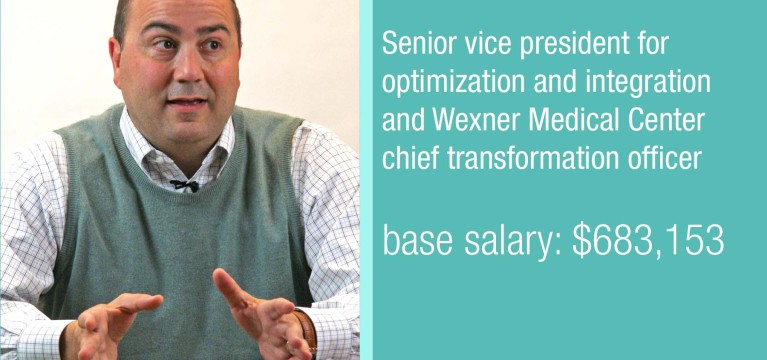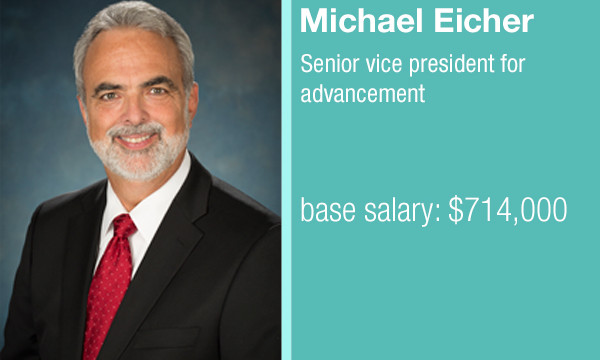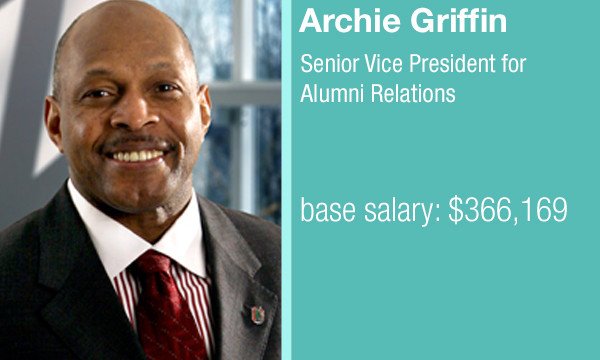Five-star hotels and private jets – some Ohio State senior administrators are traveling in style on the university’s dime.
Some travel is necessary. Everything, including universities, is moving toward a globalized model. However, some think this move could represent a shift in universities’ core priorities, especially in a time where budgets are tight and tuition is rising.
Some officials’ trips show a discrepancy in their intended purposes. One trip taken by two of OSU’s senior administrators was supposed to be a compliance review of the university’s Global Gateway Offices, but an itinerary indicates that a majority of the 10-day venture might have been spent building relations and seeking potential donors with about 6 ½ hours spent at the Gateway offices.
The Lantern obtained reports outlining the travel expenses and schedules for 24 of OSU’s senior administrators. These records detail hundreds of trips taken by these individuals, totaling upwards of $1.1 million in university-paid expenses in the past two years, the majority of which was spent by then-President E. Gordon Gee.
OSU doesn’t specifically budget travel for certain people or groups. Instead, individuals manage their own travel and it is budgeted to their department, Lauren Lubow, director of OSU’s Public Records Office, said in an emailed statement.
The records also don’t document all expenses related to a certain trip.
These reports “are not all-inclusive … the reports also do not necessarily reflect credit card expenditures linked to a particular trip,” she said.
They also do not include some payments made in advance. Lubow explained that the automated system OSU uses for tracking employees’ travels documents expenses in this way.
The Lantern requested the travel budgets and other records including salaries and performance reviews Jan. 23, and the request was filled March 24.
Former President E. Gordon Gee
Records detailing the travel of then-President E. Gordon Gee show more than $1 million in travel expenses from July 2011 to July 2013.
Some of that amount represents expenses for other people who might have shared flights or transportation with Gee, and Lubow said the President’s Office is reimbursed for all or part of expenses if the other travelers or the primary business purpose of the trip involves another department.
A large portion of these expenses, $332,169, went to NetJets, a private business jet rental company Gee used.
NetJet expenses are shown for domestic destinations such as San Francisco, New York, and Ft. Myers, Fla., in addition to in-state locations like Port Clinton, Cincinnati and Cleveland.
OSU policy encourages employees to use certain travel carriers when possible, OSU spokesman Gary Lewis said in an email. OSU receives discounts from American Airlines, Delta and United. Travel Solutions and Travel Designers, both based in Columbus, are “the university’s designated travel agencies,” according to the Office of the Controller website.
“These airlines are encouraged when practical, because university business travelers can realize negotiated discounts on published airfare when tickets are issued directly with one of the university’s partners,” Lewis said.
Gee’s other expenses are in relation to international destinations, including several trips to Europe totaling $61,257 and Sao Paulo for $60,710.
However, the director of the Center for College Affordability and Productivity said the cost of international travel by top university officials might be too much.
“There’s excessive amount of international travel probably going on. Universities are trying desperately to set up overseas programs,” said Richard Vedder, an economist and director of the Center for College Affordability and Productivity and professor at Ohio University.
“We should have an international dimension but it’s one of proportionality. Is it really necessary for us to be pushing the OSU brand name all over the world?” he added.
OSU has Global Gateway offices in China and India and is working to establish one in Sao Paulo, set to open this year.
“The Brazil Gateway will help the university explore partnerships with universities in Brazil through its Academic Partnership Program, designed to increase collaboration on a global level, connect students and faculty with researchers in Brazil and further facilitate global advancements on the world’s most pressing issues,” according to the Office of International Affairs website.
Gee retired from his role as president July 1, days after controversial comments he made at a Dec. 5, 2012, OSU Athletic Council meeting came under public scrutiny. Joseph Alutto assumed the presidency after Gee’s retirement.
Interim President Joseph Alutto
Alutto seems to take a bit of a slower pace than Gee when it comes to travel.
Records for Alutto show he took at least 19 trips since he assumed the interim presidency. During the same time the previous year, Gee took 25 trips.
The cost related to the trips Alutto took during fiscal year 2014 was not included in the records provided to The Lantern.
While serving as executive vice president and provost, Alutto made at least 15 trips, which totaled $6,185.
Aside from the two presidents, university officials who racked up the most travel expenses include Joseph Steinmetz and Geoff Chatas.
Executive Vice President and Provost Joseph Steinmetz
Steinmetz made at least 29 trips from August 2011 to September 2013 and received $23,472 in reimbursement from the university.
He traveled to places like Chicago, Miami and Sacramento, Calif. Records show the purposes for Steinmetz’s trips varied, including promoting OSU’s presence, peer networking and alumni relations. In addition, many trips were related to seeking potential donors.
Former Undergraduate Student Government President Taylor Stepp said he supports university administrators traveling to promote OSU’s image and seek potential donors.
“I think that (OSU does) an excellent job at raising money,” said Stepp, a fourth-year in public affairs. “From time to time, that means going out and meeting with constituents, meeting with donors. My belief is an expenditure like that is worth it if you’re getting a good return on your investment.”
Senior Vice President for Optimization and Integration and Medical Center Chief Transformation Officer Geoff Chatas
During his time as chief financial officer, Chatas took at least 25 OSU-expensed trips between July 2011 and January 2013, receiving $19,194 in reimbursements. That included international trips to London, Iceland, Paris and Quebec City.
Chatas’ current role, which he moved into March 1, is new at the university. He previously served as OSU chief financial officer and senior vice president of business and finance, titles he had held since February 2010.
Though the payment request status for all of his trips was approved, three of Chatas’ trips show partial exceptions to his initial requests for reimbursement, meaning he might not have gotten reimbursed for the total amount that he spent.
There was a reimbursement exception for a trip he took in September 2011, described as an “MIT visit,” which was missing a dinner receipt. A January 2012 trip to San Francisco for a health care conference shows six missing receipts and a personal meal that was $144 more than the amount the university allows to be reimbursed.
In addition, reimbursement was submitted after 90 days for a June trip to Aspen, Colo., for a higher education forum and the cost of the trip was 20 percent more than the original estimated total cost.
The Office of the Controller sets per diem rates for meals and incidental expenses for OSU employees.
Controlling travel expenses this way gives employees a daily allowance for what they are permitted to spend. The rate varies depending on specific cities, states and countries. OSU follows per diem rates established by the U.S. General Services Administration, according to the Office of the Controller website.
Employees can spend 25 percent of the per diem rate on breakfast, 25 percent on lunch and 50 percent on dinner.
If an employee goes over the permissible amount, the difference is not reimbursed, Lewis said. If an employee reports travel expenses more than 90 days after the trip they might not be reimbursed “depending upon any extenuating circumstances.”
In addition to the frequency of trips Chatas made, he stayed in luxury hotels and flew first class.
The Dayton Daily News reported that in February 2012, Chatas flew to Florida on OSU’s private jet and stayed at the five-star Ritz-Carlton in Naples, Fla. In July 2011, he also stayed in a five-star hotel in Manhattan, expensed by OSU.
Vedder said while some travel is necessary for someone in Chatas’ position, the level he has reached is excessive.
“I don’t know why a CFO of a domestic American university needs to do very much international travel,” Vedder said.
Two other administrators also received five figure reimbursements.
Senior Vice President, General Counsel and Senior Adviser to the President Christopher Culley
Culley received $14,571 in compensation for at least 13 trips taken between July 2011 and April 2013. This included a payment of about $152 for attending the 2012 Gator Bowl “as a representative of the university.”
Culley and Chatas traveled to Beijing, Shanghai, Hong Kong and Mumbai, India, in July 2012 for a “compliance review” of the China Gateway and India Gateway. However, a trip itinerary shows a majority of time budgeted for meeting with alumni and potential fundraising and about six and a half hours scheduled to actually be at the Global Gateway offices.
OSU opened a Gateway office in Mumbai, in March 2012 and the China Gateway in June 2010 but has been working to expand that office ever since.
The pair made the trip “at the request of the university Board of Trustees Audit and Compliance Committee,” Lewis said. “The goal was to review the compliance and audit functions of those offices and to obtain a firsthand account of university’s operations and activities there.
“Recognizing the cost associated with such a trip, they sought to maximize their time there by also meeting with a number of key donors, alumni, business associates and friends of the university to further advance the university’s interests in those two cities (Shanghai and Mumbai) of strategic importance to Ohio State.”
Chatas was reimbursed $8,594 for the trip and Culley was reimbursed $5,024.
The trip included an OSU-funded alumni cocktail reception in Beijing that cost $2,808 and an $4,254 alumni event in Hong Kong.
An itinerary for Chatas was not provided. However, one for Culley shows that he flew first class from Chicago to Beijing where he spent about a day and a half before flying business class to Mumbai.
Chatas and Culley stayed in luxury hotels in Beijing and Mumbai, that cost $220 and $365 per night, respectively.
While in Mumbai, Culley met with an Indian government official and the purpose for the visit was a “possible fundraising angle.” Culley spent two hours at the Global Gateway India office, according to his itinerary.
Culley spent about a day in the city before flying business class to Hong Kong.
While in Hong Kong, Chatas and Culley stayed at the Mandarin Oriental hotel. The hotel’s website boats 28 celebrity “fans” of the hotel including actors Morgan Freeman, Kevin Spacey and Liam Neeson. The hotel cost $592 per night.
While in Hong Kong, Culley attended a dinner with Fisher College of Business students to “demonstrate support to study abroad groups.” The following day, Culley met with endowment fund managers before flying business class to Shanghai. There, Culley’s itinerary showed 4 1/2 hours at the Gateway office for the “Gateway annual audit.” After a free day for “personal time and tours” in Shanghai and an OSU alumni reception, Culley flew first class back to the U.S.
Executive Dean and Vice Provost for the College of Arts and Sciences David Manderscheid
Manderscheid received $10,085 for at least 10 trips taken between July 2013 and December 2013. Manderscheid’s travels included a $423 expense while attending the Big Ten Championship Game in Indianapolis to meet with potential donors.
Manderscheid was named executive dean and vice provost for the College of Arts and Sciences after Steinmetz, who held the post before Manderscheid, was appointed to provost. Steinmetz’s promotion in turn followed the November 2012 announcement that Alutto was stepping down as provost.
Senior Vice President for Administration and Planning Jay Kasey
While most administrators’ trips were tied to promoting OSU’s image, some related to more concrete university logistics.
Kasey was reimbursed $2,448 for eight trips made between October 2011 and April 2013 related to the North Residential District Transformation. The locations were not listed for all trips, but included Cleveland and Philadelphia.
The North Residential District Transformation project is a $370 million renovation to North Campus that aims to add 3,200 additional beds through the construction of 11 new buildings as part of OSU’s plan to require second-year students to live on campus starting in fall 2016. The project broke ground in August 2013 and is scheduled to be completed in fall 2016.
These trips for the project “occurred over a critical development period” in the “initial design phase,” Lewis said, during which Kasey “provided input and direction to ensure the project progressed appropriately.
“The travel associated with this project included a benchmarking review of other universities’ best practices as well as on-site inspection of the finished product on which the potential design teams had previously worked.”
Potential Impact
Vedder said he’s concerned about the amount and cost of travel by university administrators, especially at a time when many institutions are seeing tuition increases.
Vedder said excessive travel, in addition to large salaries and other perks for senior administrators, represent a shift in universities losing sight of their primary mission which should be “to disseminate knowledge.”
John Curtis, director of research and public policy for the American Association of University Professors, agreed that in some cases, paying for top university officials travel “represents a misplaced priority.”
“There would be some concern with the growing number of administrative positions that the travel may be just to justify the work that administrators are doing and taking away from that fundamental mission of education,” he said.
A tuition freeze was enacted for in-state undergraduate students for the 2013-14 school year, after tuition rose 3.5 percent for the 2012-13 academic year. Lewis did not immediately respond Friday about whether tuition would be raised for the 2014-15 academic year.
While many students are graduating with increasing amounts of loan debt, some experts in higher education see a disconnect with the amount of money universities are investing in non-instructional staff, be it for travel or in salaries and bonuses.
“It seems to be a complete misplaced priority to be investing in just a few senior administration at a time when the spending on the academic program is so tight,” Curtis said.
This story is the fifth in a series about Ohio State’s administrators, including travel expenses and performance reviews over the last two years. The series was made possible by the generosity of Ohio State and The Lantern alumna Patty Miller.
A look at some of OSU’s administrators:




















